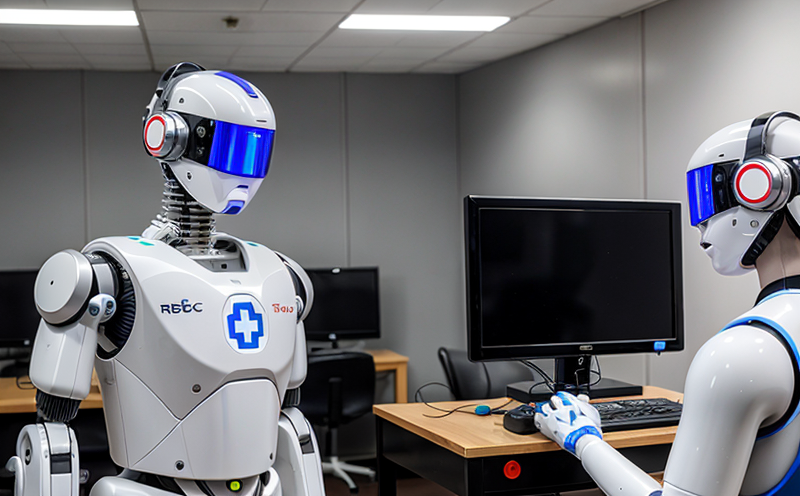ISO 10993-11 Systemic Toxicity Evaluation of Robot Materials
The ISO 10993 series is a crucial set of standards that guide the evaluation and testing of medical devices to ensure their safety for human use. The specific standard we focus on here, ISO 10993-11:2018, addresses systemic toxicity evaluations involving robot materials used in medical applications. This service ensures that robotics components do not introduce harmful substances into the patient’s body.
Testing under this standard involves a comprehensive assessment of materials to ensure they are biocompatible and do not cause adverse reactions when implanted or in contact with bodily fluids. The process includes extracting leachable substances from the robot material, evaluating them for toxicity, and ensuring that any released compounds are below specified thresholds.
The testing protocol is designed to mimic real-world conditions as closely as possible. For instance, it considers how materials might interact with physiological environments such as blood, tissues, or bodily fluids over extended periods. This approach ensures that the results accurately reflect potential risks in clinical settings.
The evaluation typically involves several steps: initial material characterization, extraction of leachable substances under specific conditions (e.g., pH levels and temperatures), analysis using advanced analytical techniques like chromatography, spectrophotometry, or mass spectrometry. After identifying the compounds released, a battery of tests is conducted to assess their toxicity.
The testing methodology must comply with strict guidelines set forth in ISO 10993-11 and other relevant standards such as ASTM F713, which provides additional insights into biocompatibility testing. Compliance ensures that the results are internationally recognized and accepted by regulatory bodies worldwide. This standardization is critical for manufacturers aiming to meet global market requirements.
The process also involves a risk assessment phase where potential hazards associated with each identified compound are evaluated. If any substance poses unacceptable risks, corrective actions are necessary before proceeding further. This step ensures that only safe materials reach the healthcare market.
It is essential to note that this testing not only protects patients but also enhances product safety and reliability, thereby fostering trust among medical professionals and consumers alike. Compliance with these standards helps manufacturers meet regulatory requirements, ensuring products are both safe and effective for use in complex robotic systems within hospitals or other healthcare facilities.
- Materials tested under ISO 10993-11 include those used in surgical robots, rehabilitation devices, patient monitoring equipment, and any other robotic systems interfacing directly with patients.
- The scope covers not just the material itself but also how it interacts with biological fluids like blood, plasma, or bodily tissues over extended periods.
- Testing is conducted under conditions that mimic real-world use to ensure accurate assessment of potential risks associated with material exposure.
Why It Matters
The significance of ISO 10993-11 cannot be overstated, especially in the rapidly evolving field of medical robotics. As robots become more integrated into healthcare settings, ensuring their materials are biocompatible is paramount to patient safety and effective treatment outcomes.
Failure to adhere to these stringent testing protocols can lead to severe health complications for patients who come into contact with robot components during surgery or therapy sessions. For instance, the release of toxic substances from improperly tested materials could cause adverse reactions such as inflammation, infection, or even organ failure.
The consequences extend beyond individual patient safety; they also impact the reputation and credibility of medical device manufacturers. Non-compliance can result in product recalls, legal actions, and financial losses. Regulatory bodies like the FDA or EU-MDR require rigorous testing to ensure compliance with international standards, making this service indispensable for any manufacturer operating within these jurisdictions.
Beyond regulatory compliance, adhering to ISO 10993-11 enhances the overall quality and reliability of robotic systems used in healthcare. It ensures that patients receive safe and effective treatments without unnecessary risks from their medical devices. Moreover, it contributes significantly to public trust by demonstrating a commitment to patient safety.
For research and development teams within the sector, this service provides valuable insights into potential hazards associated with new materials or design changes. Early identification of risks allows for timely modifications, ensuring that innovations are both safe and beneficial for patients.
International Acceptance and Recognition
- The ISO 10993-11 standard is widely recognized by regulatory bodies across the globe, including the FDA in the United States, the MHRA in the UK, and the TGA in Australia.
- Many countries that have adopted the EU-Medicaments Directive recognize this standard as a crucial component of their medical device approval processes.
- The World Health Organization (WHO) also endorses these standards for ensuring global interoperability and patient safety.
- Compliance with ISO 10993-11 is often seen as a key differentiator in the competitive market, especially when dealing with complex robotic systems that require stringent biocompatibility assurances.
Environmental and Sustainability Contributions
The evaluation of robot materials for systemic toxicity not only ensures patient safety but also plays a role in promoting environmental sustainability. By identifying harmful substances early in the development process, manufacturers can design more eco-friendly robotic systems.
Materials that pass ISO 10993-11 testing are less likely to contain hazardous chemicals or heavy metals that could leach into the environment during disposal. This aligns with broader sustainability goals and helps reduce the ecological footprint of medical robotics.
The service also supports circular economy principles by encouraging the use of sustainable materials in robotic applications. Manufacturers can explore alternatives such as biodegradable polymers, which are less harmful to the environment when disposed of properly.





